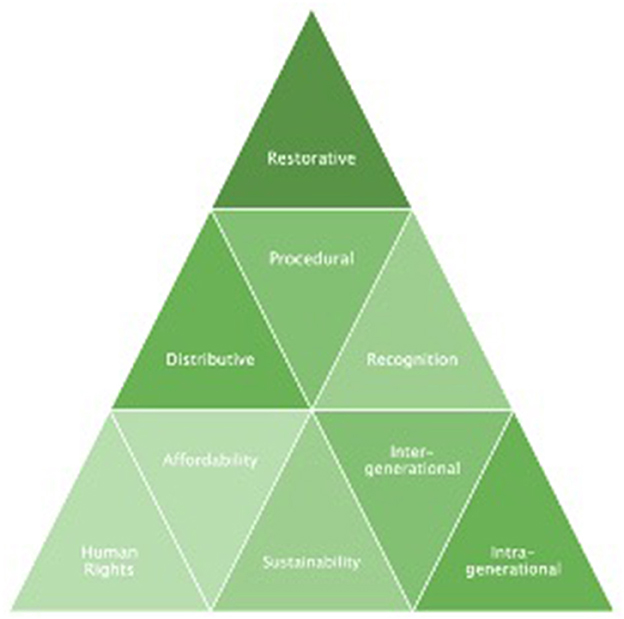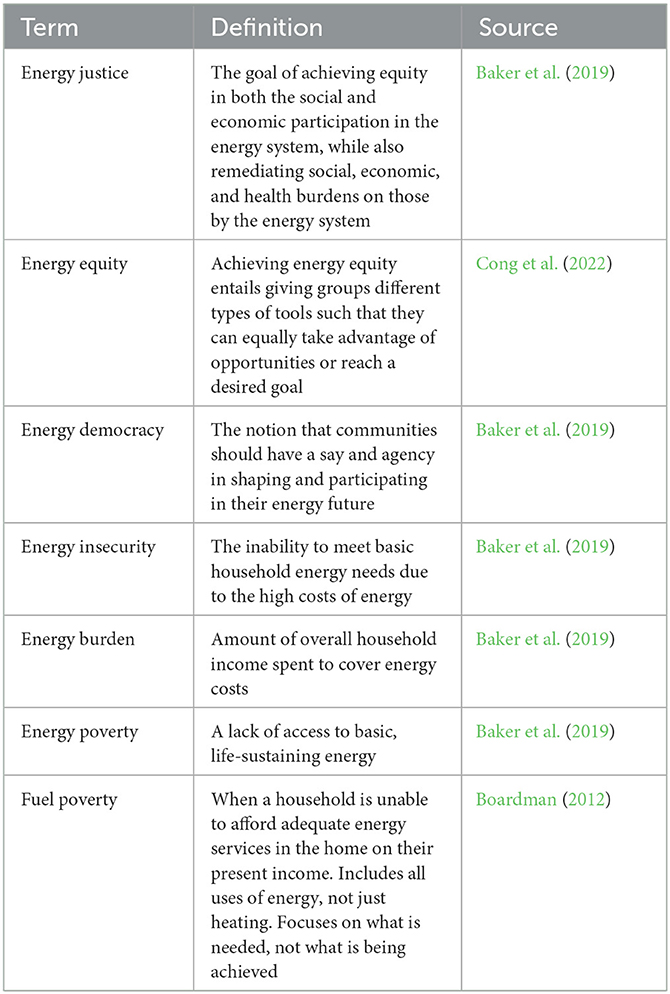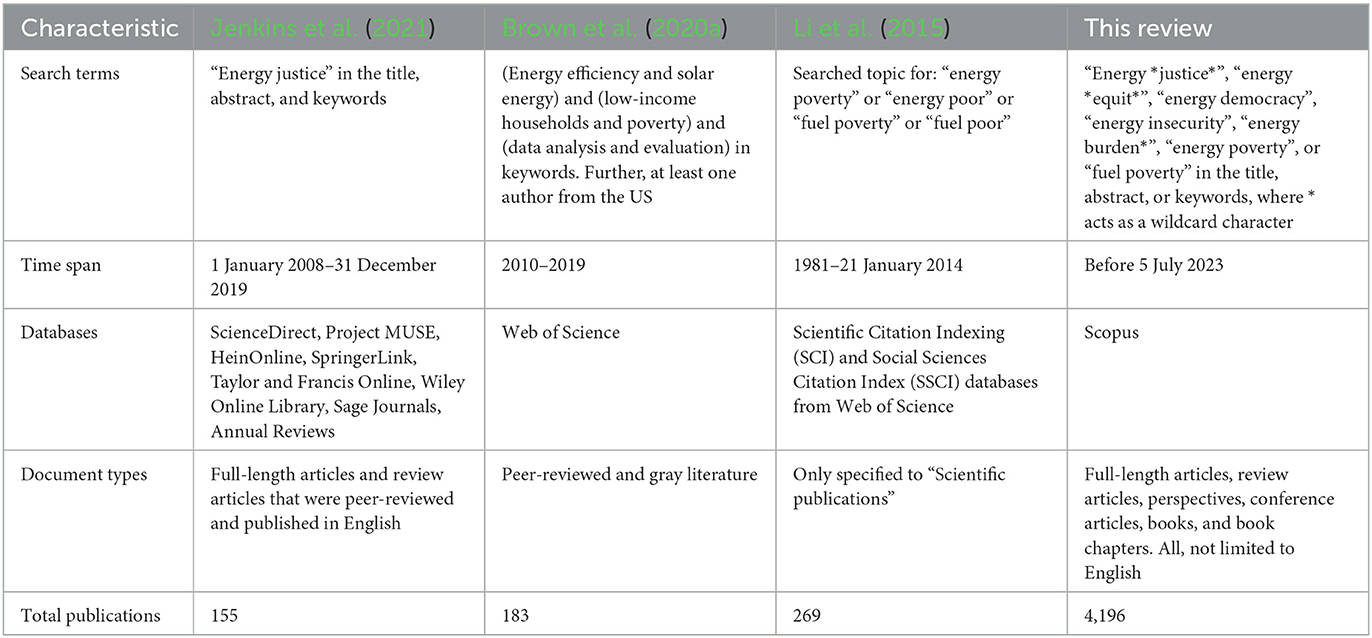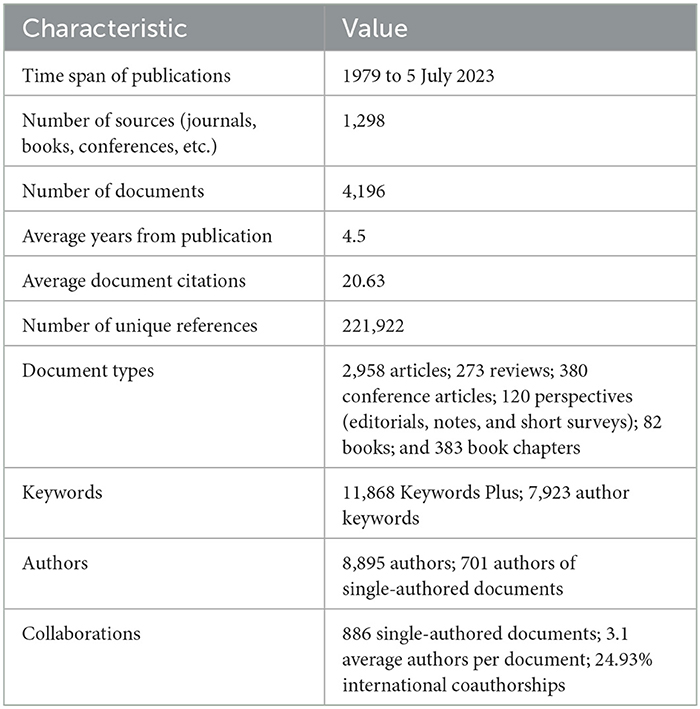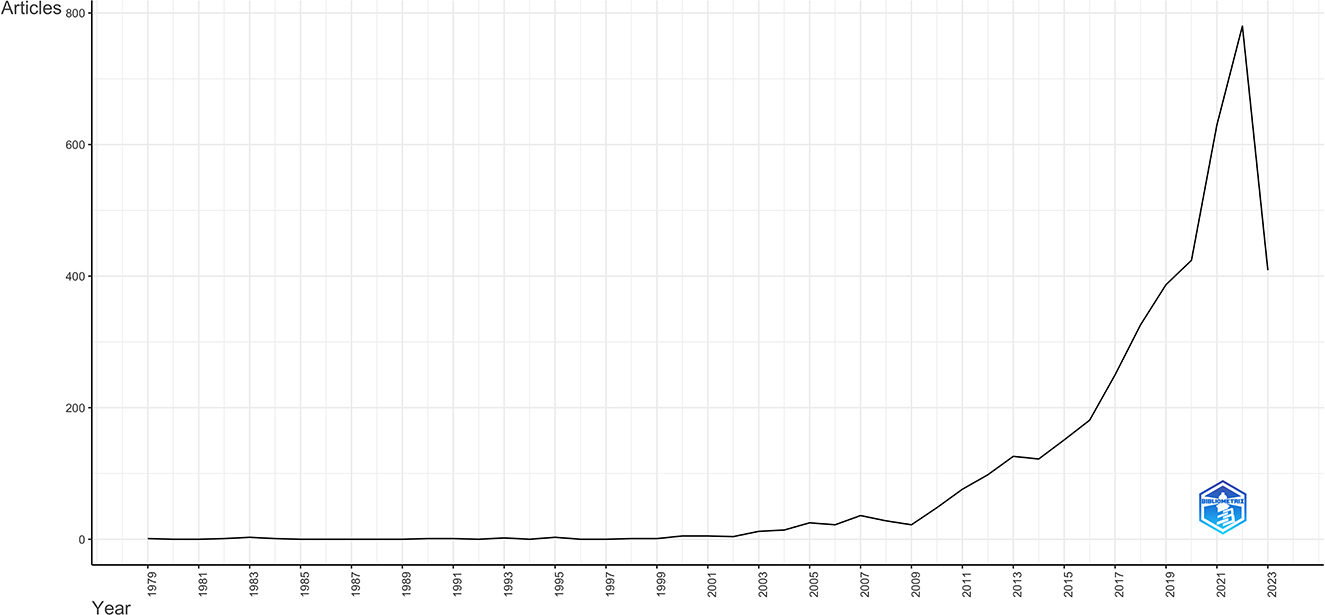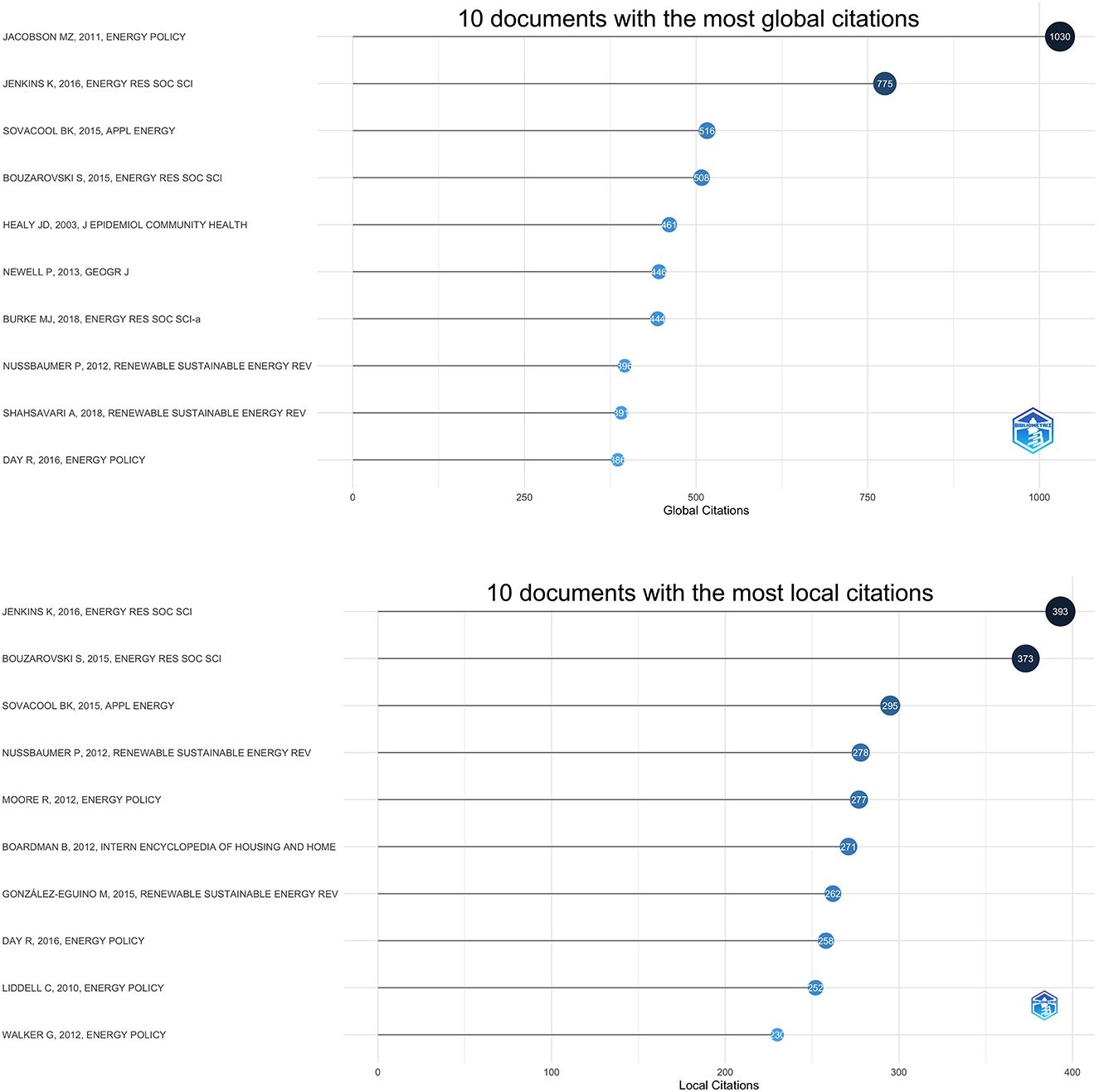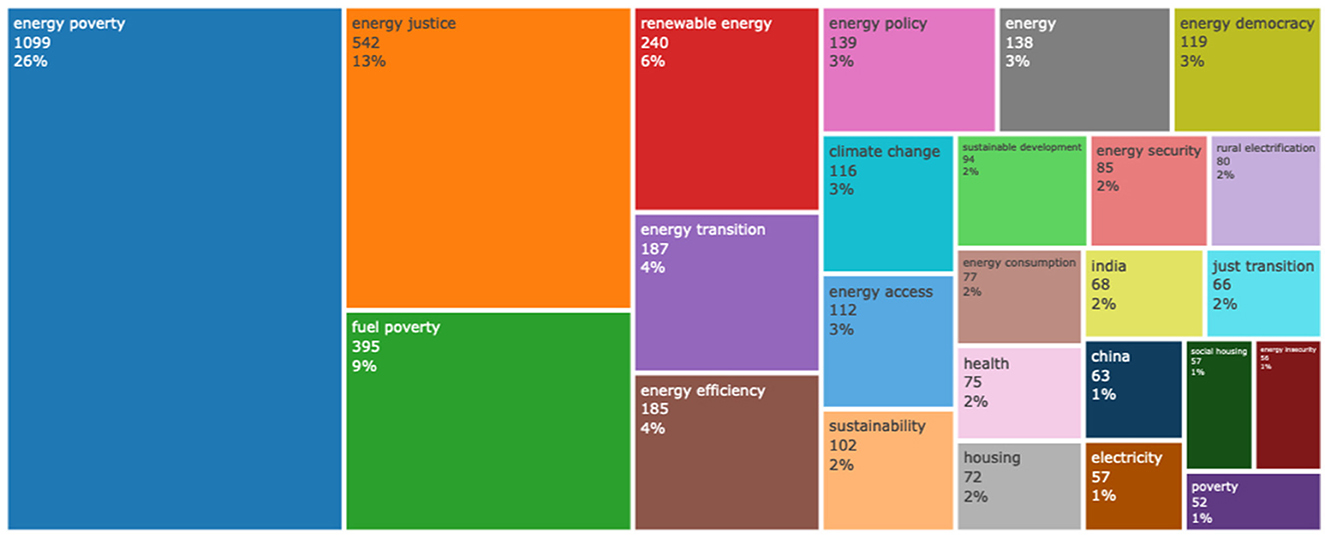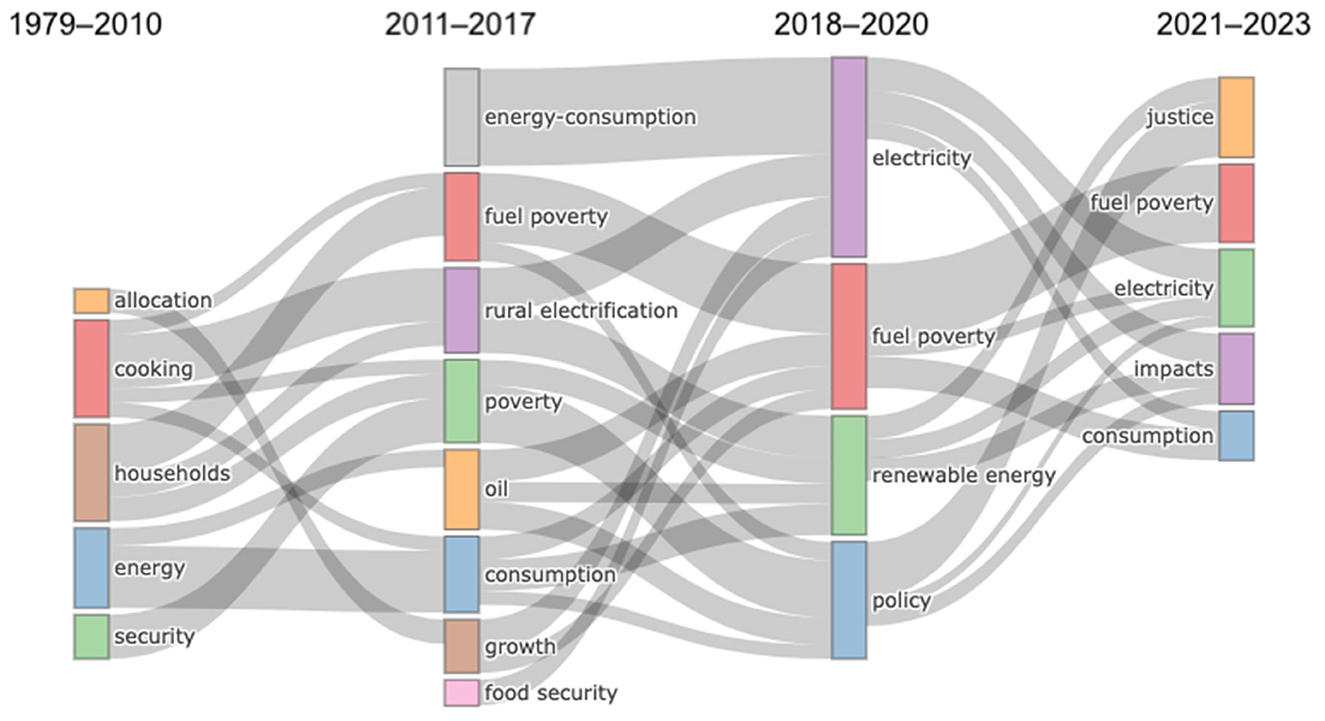- 1Renewable and Appropriate Energy Laboratory, Energy and Resources Group, University of California, Berkeley, Berkeley, CA, United States
- 2Goldman School of Public Policy, University of California, Berkeley, Berkeley, CA, United States
Introduction: Academic literature on energy justice sits at the intersection of a complex ecosystem of technologies, geographies, disciplinary traditions, terminologies, frameworks, theories, and methods. Its recent and rapid growth suggests it is of interest to a large number of stakeholders. However, these same features make aggregation and summarization a considerable undertaking.
Methods: This article uses advanced bibliometric analytics to synthesize this disparate and varied metadata to characterize trends in the treatment of energy justice in academic literature. The review covers 4,196 articles published between 1983 and 2023 with methods appropriate to the number and diversity of publications and associated subfields.
Results: We document distinct uses of similar terminologies across subfields in literature, inequitable ratios of global research compared to absolute levels of energy poverty, and the large but under-recognized contribution of cooking to the energy justice literature.
Discussion: In summarizing this voluminous literature and analyzing thematic changes over time, we provide scaffolding for more detailed reviews to place themselves within the larger interconnected literature network.
1. Introduction
Energy justice literature has seen rapid growth over its short history and has the potential for a large academic and practical impact in the future. This review presents the largest, most systematic, and most comprehensive review of the energy justice field to date, summarizing an ever-expanding network at the intersection of energy and social justice.
Energy justice refers to the goal of achieving equity in both the social and economic participation in the energy system, while also remediating social, economic, and health burdens on those historically harmed by the energy system (Baker et al., 2019).
As both a goal and an emerging academic field, energy justice is incredibly multifaceted. Literature on energy justice evaluates the justice implications of a wide range of technological fields (solar, wind, fossil fuels, buildings, transportation, grids, etc.) on many different levels of demographic and social vulnerability (minorities, gender, income, health, etc.). In addition, energy justice questions encompass geographies all around the world, upstream and downstream effects, from the mining of rare earth minerals to waste cycles, different time scales of impact, whether injustices occur in the “access to” or “realization of” the energy technology or quality, and whether energy benefits or burdens are being distributed, in addition to many other issues.
This multifaceted field houses a plurality of frameworks and theories. In a 2016 conceptual review of the field, Jenkins et al. (2016) proposed a framework that includes distributive, procedural, and recognition justice as the three core tenets. Distributional energy justice evaluates the allocation of the benefits and burdens of energy. Procedural energy justice is the equitable engagement of all stakeholders in decision-making and requires “participation, impartiality, and full information disclosure.” And finally, recognition of energy justice calls for fair representation and the offering of complete and equal political rights to all individuals (McCauley et al., 2013). These three tenets, which are placed in the middle tier of the theory pyramid in Figure 1, are often accompanied by restorative justice (Heffron and McCauley, 2017). Restorative justice is an approach adopted from criminal justice—articulated in Zehr's (1990) book Changing Lenses—A New Focus for Crime and Justice—that involves all the stakeholders involved in a crime to address the harms, needs, and obligations arising from the crime by putting right and enabling healing to the greatest extent possible. Restorative justice is placed at the top of the pyramid to acknowledge the prior and ongoing harm to low-income communities and communities of color that create unequal baselines and endowments.
In addition to the three tenets framework, Sovacool et al. promote a framework approach consisting of many core principles. Their list has included human rights concerns, availability, affordability, due process, good governance, transparency and accountability, sustainability, intra- and intergenerational equity, responsibility, resistance, and intersectionality (Sovacool and Dworkin, 2015; Sovacool et al., 2016, 2017). Five of these principles form the foundation of the theory pyramid in Figure 1.
Finally, the field has a long dictionary of overlapping terminologies (see Table 1). The Initiative for Energy Justice (IEJ) created a workbook that discusses the range of terms associated with ‘energy justice' broadly and how these terms are used by both academics and practitioners (Baker et al., 2019). Their list of common terms includes energy justice, energy equity, energy democracy, energy insecurity, energy burden, and energy poverty, of which each has different associations. To this list, we have added the related term fuel poverty, which most closely parallels the meaning of energy insecurity and appears earlier in the literature.
The core intellectual roots of energy justice are composed of literature on environmental and climate justice as well as discussions of inequality and justice from political philosophy and ethics (Baker et al., 2019). While energy justice builds on these longer-established disciplines, the field itself is quite new, only emerging academically in 2017. The multiple facets, the plurality of theories, and the large dictionary of terms not only offer the field the opportunity for wide reach and transcendence of many issues but also demonstrate its scattered nature. In the most comprehensive review prior to this article, Jenkins et al. (2021) note that “efforts are generally more multidisciplinary than interdisciplinary, and it is a potentially ‘corruptible concept', highly vulnerable to a range of political agendas”.
This complex and voluminous literature requires scalable approaches to synthesize insights and trends. We leverage advances in systematic literature review approaches and visualization to address this gap. Bibliometric methods are uniquely suited to the systematic and comprehensive review of the diverse academic literature composing the field of energy justice. By adopting this approach, we describe the superstructure within the energy justice field, showing interlinkages and thematic evolutions, and providing a scaffolding that will support future research.
2. Methods
Bibliometrics is the use of statistical methods to review and map scientific literature through systematic, transparent, and reproducible processes. Bibliometrics is a particularly suitable scientific mapping technique for voluminous, fragmented, and controversial research fields because it provides objective and reliable analyses. It can provide structured analysis to a large body of information, infer trends over time and themes researched, identify shifts in the boundaries of the disciplines, detect the most prolific scholars and institutions, and present the “big picture” of a field of research (Aria and Cuccurullo, 2017).
This article performs a bibliometric review of academic energy justice publications primarily using the R-package biblometrix described by Aria and Cuccurullo (2017). Their flexible, open-source tool allows scholars to follow the complete scientific mapping workflow using substantial and effective statistical algorithms and data visualization tools.
While Jenkins et al. (2021) review was systematic and comprehensive of their stated scope, by using time-intensive manual methods, they reviewed 155 academic articles published between 2008 and 2019. In addition to Jenkins et al. (2021) highly cited review, we identified three other articles that applied bibliometric analysis methods, to varying degrees, to subsets of the energy justice literature. First, Brown et al. (2020a) in Energy Research & Social Science used bibliometric methods to examine the persistence of energy burdens (high proportion of income spent on energy bills) in the United States. Their article presents an ecosystem of energy energy-burden stakeholders and then visualizes thematic clusters and trends over time. Second, later in 2020, several of the authors from Brown et al. (2020a) published a second review in Progress in Energy that takes a more qualitative and narrative approach to reviewing the “magnitude, causes, correlates, and impacts of the energy burden currently experienced by low-income households in the U.S (Brown et al., 2020b).” They expand on the design and cost-effectiveness of programs designed to reduce energy poverty in the United States. Third, Li et al. (2015) offered bibliometric results on energy poverty (referred to as the lack of modern energy services, primarily related to developing countries) and fuel poverty (referred to generally as the lack of ability to afford adequate warmth in the home, primarily pertaining to households in Europe). This quantitative review focused on reporting numbers and terms rather than on insights.
The computational methods used in this analysis allow for the expansion of the time span, search terms, and types of publications to review 4,196 academic publications published and available on the Scopus Database on or before 5 July 2023. Table 2 compares the scope and search criteria of this review to those of Li et al. (2015), Brown et al. (2020a), and Jenkins et al. (2021).
The primary difference is the dramatic expansion of the review's search terms in this analysis. Instead of narrowing the search to only articles that include one term explicitly in the title, abstract, or keywords, the search was broadened to include all of the terms that Table 1 identifies from the social science and legal literature (Baker et al., 2019) in addition to fuel poverty. All terms were searched, as well as synonyms to each of the terms, and their plural forms. By using an asterisk wildcard character as a simplified form of regular expression, the search term “energy *justice*” was used to find documents that included energy justice, energy injustice, energy justices, or energy injustices. This analysis did not explicitly include energy security as this term generally refers to a different, well-established literature at the intersection of electric power systems, risk, and global energy governance. Still, our search results identified several articles that discussed energy insecurity on a national scale rather than on a household scale. Since “energy justice”, broadly speaking, is a fragmented and multidisciplinary field, a narrow selection of search terms risks missing large portions of the literature.
Several additional steps were taken to ensure review relevance. Nearly 160 articles were removed that used a definition of energy burden from the fields of biology, microbiology, zoology, and ecology which refers to metabolic energy burden on an organism scale or societal systems scale. We removed duplicate articles using the unique accession numbers for each entry as well as manual methods. The computational review of all publications was supplemented by human scanning of all titles for relevance.
The starting date of this search is not limited in order to capture the full history of this field. This allows us to include six publications prior to 1985, such as a Harvard Environmental Law Review article from 1983 titled “Energy Equity for the Poor: The Search for Fairness in Federal Energy Assistance Policy” by Manaster (1983), and an article in the Journal of Economic Psychology titled “Social Policy Options and Fuel Poverty” by Bradshaw and Hutton (1983). Manaster (1983) discussed the financial burden of high energy costs placed on Americans since the 1973 oil embargo. Bradshaw and Hutton used data from three national surveys to evaluate policy options for relieving fuel poverty, defined as the inability to afford adequate wealth in the home (Bradshaw and Hutton, 1983). We do not assume that these were foundational articles to fuel poverty research, as both seem to imply prior research, but that they were some of the earliest articles accessible in the Scopus database. While the earliest article found for this review was published in 1979, there were only 15 (0.36%) results published before 2000 and only 87 (2%) results between 2000 and 2007. Therefore, expanding the review's temporal scope does not significantly change the following analyses. Nonetheless, the date range was expanded for comprehensiveness.
This analysis searched the Scopus database for depth, standardization of documentation, and integration with the bibliometrix R-package. Scopus is one of the largest abstract and citation databases of peer-reviewed literature including scientific journals, books, and conference proceedings. Their curated collection contains the contents of over 25,800 unique peer-reviewed scholarly journals covering disciplines across social sciences, physical sciences, health sciences, and life sciences. Forty-two percent of the energy justice literature in this review is published in only nine journals: Energy Research and Social Science (n = 371), Energy Policy (n = 320), Energies (n = 130), Sustainability (n = 121), Energy Economics (n = 113), Energy and Buildings (n = 99), Renewable and Sustainable Energy Reviews (n = 77), Applied Energy (n = 66), Energy for Sustainable Development (n = 66), and Energy (n = 62). Source clustering through Bradford's law identifies these 10 of the 1,298 total sources as core sources, or the nucleus of journals particularly devoted to this subject.1
Since this database has complete coverage of these most popular journals, the use of this single database is sufficient for the following analysis. As a verification step, the search terms from Jenkins et al. (2021) were reproduced in the Scopus database, resulting in 187 academic articles, which is larger than, and broadly inclusive of, their 155-article review. This may be due to later steps by the authors to remove articles they found not to be relevant to the overall review even though the articles fit the explicit search criteria. As found in this review, the articles that fit the name of the search criteria but not their spirit may have focused on energy security as in national security risk or may be published in a language other than English.
The acceptable document types were finally expanded to include articles, reviews, proceedings, books, and book chapters. Book reviews, corrections, notes, letters, and editorial materials were all excluded as they were largely repetitive of the original content provided in the included document types. This review also did not limit the language of publication. Not limiting publications to just those published in English added 87 results published between 1979 and 2023. Many of these articles defined energy poverty for different local contexts, such as in Italy, Mexico, or Argentina, and all metadata (most importantly, the title, abstract, and keywords) were written in English. By including these diverse global perspectives, this review prioritizes equity in its methods as well as its subject matter.
2.1. Methodological limitations
This review has three key limitations. First, similar to all bibliometric analyses, this review does not use the full text of articles, only the extended metadata. The metadata includes the title, abstract, authors, journal, research area, publication date, keywords, citations, times cited, and funding information, among others. While the full text of many of the included articles is open access, many others remain behind journal paywalls. The crucial contribution of this bibliometric review to the field lies in its reproducibility, breadth, and ability to reveal superstructures. Therefore, this analysis does not pursue the large additional methodological and computational burden that compiling and digitizing the full texts entails.
Second, the broad search terms result in the inclusion of a small number of publications where energy justice, as defined earlier, is not the primary focus. For example, publications that examine technology and are described as having ‘the potential to reduce energy insecurity' or are motivated by ‘overcoming worldwide energy poverty and climate change'. Their limited presence is acknowledged but not removed at present from the much larger analysis. En masse, the strength of the systematic methods outweighs the limited presence of outliers. As detailed earlier, several steps were taken to ensure overall review relevance including removals of biological literature and manual human scanning of all publications.
Using a scientific publication database excludes the important energy justice grassroots and activist perspectives in gray literature. Compiling and extending similar methods to this extensive gray literature provide a promising opportunity for future research. Fuller and McCauley's (2016) article titled “Framing Energy Justice: Perspectives From Activism And Advocacy” provides an excellent starting point by developing an analytical framework for assessing the emergence of energy justice in the activist and advocacy areas through a survey of organizations in Philadelphia, Paris, and Berlin. The Energy Justice Workbook expanded upon Fuller and McCauley's (2016) work in Section 1.1 on energy justice in practice (Baker et al., 2019). In this section, the authors reviewed statements of practitioners and advocates, finding that they rely less on the terms energy justice and more on energy equity or energy democracy. Carley et al. (2021) provide a non-comprehensive review of energy justice programs in the United States on which future work can be built. However, these cross-cutting energy justice issues are faced by communities around the world; therefore, a focus on any one country may leave out key themes.
Table 3 describes the resulting contents of this review.
3. Results
3.1. Dramatic growth
The energy justice field has grown quickly since 2009, with a compound annual growth rate of 14.65%. Jumps in productivity in 2018 and 2021 (measured by the slope of scientific production) indicate turning points in the field (Figure 2). As of 5 July 2023, there were already 409 articles published, further indicating that the field has a strong growth trajectory.
3.2. Prolific authors and highly cited publications
In a similar fashion to Li et al. (2015), published 8 years ago, we find that Benjamin K. Sovacool is by far the most prolific author in this field, even when considering fractional coauthorship. In contrast to traditional publication measurement where all authors gain one publication no matter the number of coauthors, fractional coauthorship divides the contribution of each publication between the number of coauthors (i.e., 2 co-authors on one publication each are attributed 0.5 fractionalized authorship). Sovacool authored 82 publications in this review, equivalent to a fractionalized authorship of 37.35, more than three times higher than the next most prolific author. The domination of this academic literature by one author indicates both their core contribution to the growing field and the field's immaturity as an academic dialogue. The lack of a more diverse authorship is surprising for this global, ethical topic. While energy justice is a rapidly growing field that has gained much academic interest, it may not yet have matured into a thriving intellectual exchange among many researchers. Notable other authors ranked by their number of publications include Bouzarovski (n = 33), McCauley (n = 29), Heffron (n = 26), Gouveia (n = 20), Pachauri (n = 20), and Simcock (n = 20).
To distinguish impact within the energy justice field from larger academic import, this article separates global and local citations. Global citations measure citations from documents in the entire database, reflecting the more common interpretation of a publication's citation count. Local citations measure the citations a document has received from within the analyzed review. Therefore, while global citations reveal publications of interest to the entire academic community, local citations indicate the importance of the review itself. The list of local citations also includes articles that are not in the original review but are highly cited by it, further overcoming issues surrounding the inclusion of specific keywords. Figure 3 shows the 10 most cited documents globally (top) and locally (bottom).
The example of the most globally cited article immediately demonstrates the importance of evaluating local citations instead of global citations in a bibliometric review process. Jacobson and Delucchi (2011) article titled “Providing All Global Energy With Wind, Water, and Solar Power, Part I: Technologies, Energy Resources, Quantities and Areas of Infrastructure, and Materials” has the most global citations, with 1,030, but only 17 local citations. Upon inspection, this article was included in this review because of its use of the term energy insecurity in the first sentence of the abstract. Energy insecurity was used twice more throughout the text of the article but only as a motivator as in the sentence “Climate change, pollution, and energy insecurity are among the greatest problems of our time.” Therefore, within this field, it has little relevance, even though it has the most overall citations.
Jenkins et al.'s (2016) review titled “Energy Justice: A Conceptual Review” is the most locally cited article and the second-most globally cited article. Therefore, it has significant import both to the larger academic community, as well as the energy justice community. Their review introduces the previously mentioned three tenets approach of distributional, recognition, and procedural justice and proposes a research agenda for the field.
Next, we compare the source of publications between documents in the review and documents cited by publications in the review. Documents in this review were most often published in Energy Research and Social Science (8.8%), but cited documents were most often published in Energy Policy (6.2%). Both of these Elsevier journals, as well as another, published prescient special issues on energy justice that encourage the academic development of the field. Energy Policy published the special issue “Exploring the Energy Justice Nexus” in 2017 (McCauley et al., 2017), Energy Research and Social Science published “Energy Demand for Mobility and Domestic Life: New Insights From Energy Justice” in 2016 (Simcock and Mullen, 2016), and Applied Energy published ‘Low Carbon Energy Systems and Energy Justice' in 2019 (McCauley et al., 2019).
Overall, there are significant similarities between the most globally cited documents and the most locally cited documents indicating the strong links between energy justice and related fields. Table 4 provides a brief synopsis of the ten most locally cited documents in this review and summarizes the key texts recognized within this diverse interdisciplinary field.
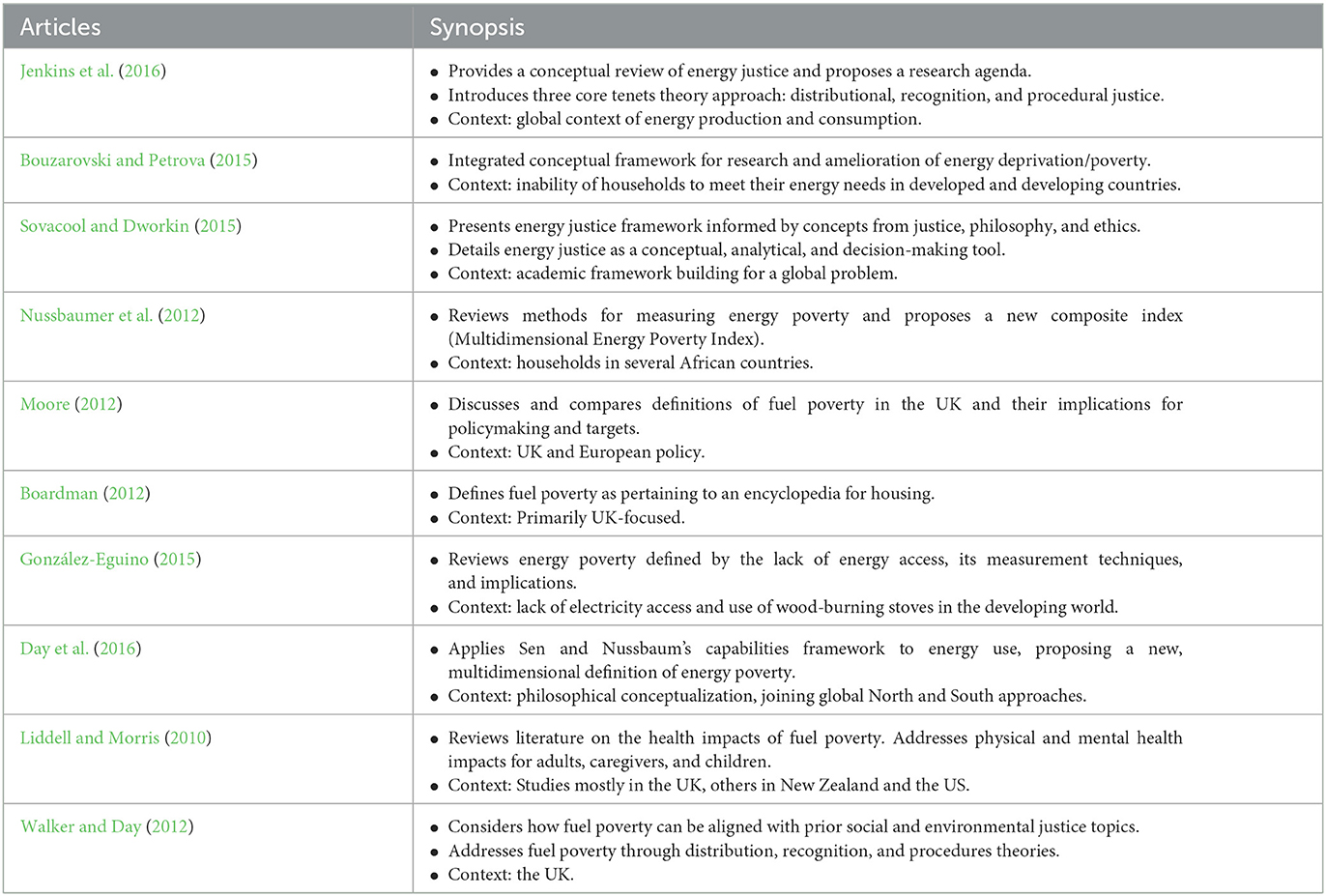
Table 4. Synopses of the 10 most locally cited documents in this review, in decreasing order of local citations.
Summarizing these 10 most locally cited articles provides an indicative map of the field. For example, four of the articles take a global perspective of their energy justice issue (Bouzarovski and Petrova, 2015; Sovacool and Dworkin, 2015; Day et al., 2016; Jenkins et al., 2016), four focus primarily on issues in the United Kingdom (Liddell and Morris, 2010; Boardman, 2012; Moore, 2012; Walker and Day, 2012), and the final two examine issues in the developing world (Nussbaumer et al., 2012; González-Eguino, 2015).
Figure 4 begins to investigate this (lack of) geographic diversity by visualizing the authors' affiliation locations around the world. An author's affiliation country does not necessarily represent the article's study location, but it may be indicative. The disproportionately small presence of sub-Saharan Africa in both the focus of the 10 most locally cited articles and the geographic distribution of authors serves as a stark contrast to the large absolute levels of measurable energy poverty in the sub-continent. There were no articles published in any African language. These results suggest that (1) academic research into energy justice, broadly defined, is not commensurate with absolute need and (2) individuals from the studied countries are often not involved in the formal publication process. Although these problems are not unique to energy justice, it is particularly pertinent for energy justice to center and involve the voices of those directly affected.

Figure 4. Country Scientific Production: number of documents with at least one coauthor's affiliation located in each country.
The examples of publications from countries in Central and Latin America reveal further disconnects between the absolute energy poverty burden of individuals, the proportion of research on those locations, academic affiliations in those locations, publications in the local languages, and inclusions in the Scopus database. Of the 87 articles not published in English in this review, 42 were published in Spanish or Portuguese; however, only 11 of these have authors with affiliations in Central or Latin America. The proportion of publications and affiliations in Central or Latin America inadequately represents the long history of ‘pobreza energética' legal work and activism (Montoya, 2020). For instance, Indigenous organizing in Mexico against displacement from large-scale land grabs for wind farms (Baker, 2016) significantly influenced Director Shalanda Baker's path toward bringing energy justice into the U.S. Department of Energy system (Baker, 2021). As described by Montoya (2020), definitions of energy poverty for Latin America often appear more expansive and comprehensive than those commonly used in the United Kingdom and Europe. Latin American definitions often consider “more complex factors recognizing not only weather and geographical differences in the region but also the variety of cultural and social perceptions over energy needs and consumption” (Montoya, 2020). Scopus searches using “pobreza energética” or related terms in Spanish or Portuguese revealed no new articles, indicating that the Scopus database is more limiting than the inclusion of search terms in different languages. Bridging language barriers and inequities in global publication systems would allow for larger exchanges of ideas, perceptions, and frameworks to overcome these global issues.
Eight of the ten most locally cited articles focus on “energy” or “fuel” poverty as defined by the inability of households to meet their basic energy needs (Liddell and Morris, 2010; Boardman, 2012; Moore, 2012; Nussbaumer et al., 2012; Walker and Day, 2012; Bouzarovski and Petrova, 2015; González-Eguino, 2015; Day et al., 2016). Three of these focus on different measurement techniques (Moore, 2012; Nussbaumer et al., 2012; González-Eguino, 2015), reflecting the importance of quantification to energy poverty scholars. However, none of these articles addresses the efforts and perspectives of grassroots advocates, activists, or individuals working in or experiencing energy poverty for decades. This observation is in alignment with the Initiative for Energy Justice Workbook's note that, in general, practitioners and advocates make explicit references to centering the voices of low-income communities and communities of color, while academics tend to take a more measured approach by not explicitly centering the voices of the studied communities (Baker et al., 2019). While not ranking in the top 10, Fuller and McCauley (2016) article (which has nearly 100 local citations) fills part of this gap by articulating an energy justice frame from the perspective of advocates and activists in select locations such as Philadelphia, Paris, and Berlin.
Finally, we acknowledge the dominance of new theory frameworks presented in these articles. Nearly half of the articles introduce novel theory frameworks or conceptual approaches to energy justice or energy poverty. This finding reflects the importance of framing to unite such a complex and diverse discipline. It also indicates the importance of these particular framings, published at most 13 years ago, to make bringing the experiences of energy justice felt globally for centuries into the academic sphere.
3.3. Themes and trends
In Figure 5, the representation of author keyword frequency across all 2,290 publications confirms the dominance of the ‘energy poverty' branch of energy justice. Authors explicitly included ‘energy justice' in only 13% of publication keywords, while ‘energy poverty' was found in 26% of publication keywords. Not only are energy poverty and energy access clear energy (in)justice issues, but they also compose the majority of articles in the field. Prior reviews rarely take into account the varied terminology of this field, thereby missing these large contributions. This result also speaks to the need for studies on energy access and energy poverty to acknowledge their role in the energy justice field at large.
Of the seven search terms (energy justice/equity/democracy/insecurity/burden/poverty, fuel poverty), six appear in the top 50 keywords. Energy poverty ranks first, energy justice ranks second, fuel poverty ranks third, energy democracy ranks ninth, and energy insecurity ranks twenty-fourth.
Because this review largely draws on academic social science and law literature, one would expect similar findings to the Energy Justice Workbook in terms of terminology usage. While the frequency rankings of energy justice, energy equity, energy democracy, and energy insecurity are largely in line with their findings, this article finds significant differences in the usage of energy burden and energy poverty. Baker finds energy burden to be commonly used by social sciences and infrequently used in law but energy poverty to be rarely used by social sciences and infrequently used by law. While energy poverty appears in the keywords of 26% of publications in this review, energy burden appears in <0.6%. These results indicate that although energy poverty has a recognized prominent role in the development of the energy justice field, the burden of that poverty has not been equally explored. Authors may opt for terminology such as energy poverty as a proxy for energy burden; however, this could indicate that the field under-acknowledges the nature of that poverty, only acknowledging it as a metric rather than a burden that affects individuals across and within households differently. Nuances in language and terminology are crucial in the development of any field but particularly for a field dedicated to the justly characterizing injustice.
Beyond keyword counts, we find a much larger diversity and interconnectedness of definitions and implied contexts for each of our selected terminologies than indicated by prior reviews. For instance, when in the context of publications based in the United Kingdom or Europe, fuel poverty largely refers to the inability of households to affordably warm their homes (Boardman, 2012), whereas the inability of households to affordably cool their homes in the United States falls under energy burden (Cong et al., 2022). In literature from developing countries, fuel poverty may refer to diverse topics such as a poverty of options for energy needs, the burden of collecting firewood for cooking and heating fuel, or poor reliability (Ferrall et al., 2022) and/or affordability (Gill-Wiehl et al., 2021) of existing options. Overall, energy justice and energy equity are often used interchangeably; however, energy justice is much more common. Energy justice may imply a larger focus on more progressive frameworks, such as procedural and restorative justice, than energy equity, which generally relies on distributive justice. However, when referring to energy inequities, differences in distributions are frequently measured in reference to the equality of some energy good or service, rather than other more expansive theories of a just distribution such as a capabilities approach or basic-minimum approach. Energy insecurity is either used in the context of national-scale oil crises, or household-scale uncertainty and precarity surrounding meeting energy needs. In literature from the United States and Europe, energy burden often has a narrower definition of a percentage of income spent on energy; however, energy burdens come in many non-income forms, including development, health, and the environment. Insights from literature from Latin America may serve to expand our definitions of energy burdens to include contextual factors such as geography and weather, as well as cultural preferences and health effects. Similar to fuel poverty and energy burden, energy poverty often has more expansive definitions in literature from developing countries and refers more narrowly to the unaffordability of electricity in literature from developed countries. Related literature on energy access often falls under energy poverty but generally refers only to the use of electricity rather than energy more holistically. Therefore, without understanding the larger context of how terminologies are used across subfields and geographies, energy justice researchers may miss relevant insights from related articles using different terms.
This plurality of definitions does not necessarily represent a weakness of the field. On large and small scales, communities must ultimately decide for themselves what justice in their energy systems will mean now and in the future. However, when decided locally, these differing priorities and frameworks for justice may create contested fields where competing definitions of just energy futures conflict.
An evaluation of author keyword occurrences over time shows that energy poverty has a much longer publication history and remained the most popular author keyword through 2021. The use of energy justice as a keyword only started in 2016 and has grown quickly since. The stark difference in growth over time between fuel poverty and energy access compared to energy poverty and energy justice reinforce the disconnect in acknowledging a lack of access as a justice issue.
We next adapt the method adopted by Cobo et al. (2011) to design a conceptual structure map using a multiple correspondence analysis methodology to cluster all publications in the review into six groups based on author keyword co-occurrence and a factorial analysis (Figure 6). The origin of the map represents the average position of all articles, therefore the center of the research field. The proximity between keywords corresponds to the shared usage among articles in our review: keywords are close in the conceptual structure map when a large proportion of articles treat them together; keywords are distant when only a small fraction of articles use these words together. The intuitive literature clusters are clearly separate. For example, the purple cluster represents rural electrification in developing countries, the brown cluster focuses on thermal comfort and buildings, the blue cluster is framework and justice-focused, while the red cluster is health- and poverty-focused. The brown “buildings” cluster is farthest from the plot's origin, indicating its peripheral nature within the rest of the literature.
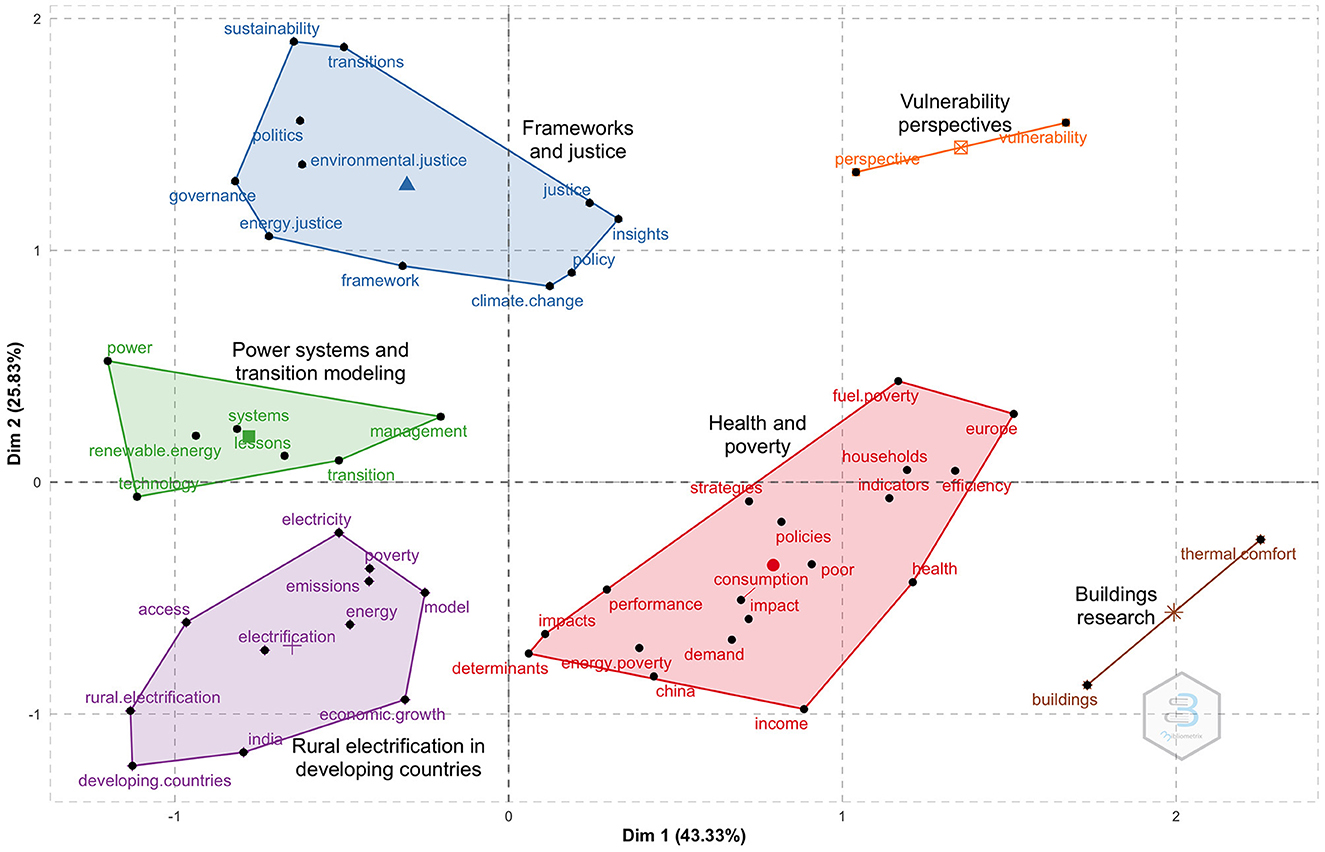
Figure 6. Conceptual structure word map on Keywords Plus generated using multiple correspondence factorial analysis. Moving clockwise from top-center, literature clusters include: vulnerability perspectives (orange), buildings research (brown), health and poverty (red), rural electrification in developing countries (purple), power systems and transition modeling (green), frameworks and justice (blue).
This multiple correspondence analysis methodology clearly outlines silos that have emerged in the field. For instance, rural electrification (the purple cluster) and health/poverty (the red cluster) are starkly distinct even though the following longitudinal analysis depicts the historic merging of cooking into fuel poverty at large (which would include electrification). The literature seems to delineate between energy–poverty–climate nexus (Casillas and Kammen, 2010) and energy–poverty–health nexus, which are not mutually exclusive (Gill-Wiehl and Kammen, 2022). It is equally important for these types of sub-literature to be in communication while also not overlooking entire subfields in their consolidation. The importance of this is evidenced by the absence of cooking, our first energy use as a species, as a keyword within the map at all.
To analyze the thematic evolution of the field longitudinally, we adapt the previously described clustering method by dividing the research set into subperiods, rerunning the clustering methodology of keyword co-occurrences within each time frame, and then examining how the sub-clusters progress over time. We divide the subperiods based on the major turning points in the literature identified in the scientific productivity chart (Figure 2): 2010, 2017, and 2020. These themes are represented by the colored vertical bars in which height represents the relative amount of literature in that theme. Flows between subperiods represent how literature in a previous subperiod would be recategorized in the following subperiod, indicating the relationships between themes across time. This unique longitudinal analysis in Figure 7 allows us to highlight the tendencies of topics to merge or split into several themes.
Early literature in this energy justice review focused primarily on households and cooking (categorized under fuel or energy poverty). These themes merged into focuses on poverty, fuel poverty, and rural electrification between 2011 and 2017. New themes such as energy consumption and food security also emerge here. The varied themes for the 2011–2017 period merge and are clarified between 2018 and 2020 into groups labeled electricity, fuel poverty, renewable energy, and policy. Justice only strongly emerges in the last subperiod, which includes 2021 through 2023 but builds out of the literature on renewable energy and policy from 2018 through 2020. Fuel poverty (aka energy poverty) is the strongest theme across all subperiods, touching nearly all other themes.
In particular, we analyze the merging of the dominant themes of cooking and households between 1979 and 2010 into fuel poverty and rural electrification by 2011. Although electric cooking is expanding, even by 2022, it is not on track to be the most prominent clean cooking option for households currently without access, nor has it provided the gains in access seen elsewhere (Gill-Wiehl and Kammen, 2022). These trends over time speak to the household level role of cooking in the early development of the energy justice literature and the larger field's shift away. The salience of energy justice's shift away from clean cooking is illustrated by the large energy justice implications of different clean cooking solutions for individuals, and the gendered inequities across individuals within households. Many of these implications for health, spending, and time are not captured when cooking is grouped with all other forms of household energy. For example, the established metrics used to indicate fuel poverty (e.g., 10% of the monthly household expenditure) rarely distinguish the 5% threshold that the Energy Sector Management Assistance Program set for cooking fuel (Boardman, 2012; Bhatia and Angelou, 2015; Gill-Wiehl et al., 2021). This consolidation, while logical for contexts of national-level grid access to electricity, leads the literature to fail to acknowledge the energy justice implications of the other more prominent clean cooking options, namely, liquified petroleum gas. The current structure of the field would also miss the justice implications of other emerging clean options such as ethanol or biomass pellets in specific advanced gasifiers. Our results indicate a growing gap in the literature on the energy justice implications of clean cooking, despite the fact that this theme was foundational to establishing the field.
4. Discussion and conclusion
In summary, this article used advanced bibliometric analytics to synthesize disparate and varied metadata to characterize trends in the treatment of energy justice in academic literature. In the largest and most comprehensive review of the field to date, this review covered 4,196 articles published between 1979 and 2023 at a scale appropriate to the number and diversity of publications. Our quantitative methods offer the ability to review this wealth of information in a truly systematic, comprehensive, replicable, and unbiased manner.
We found that energy justice literature has seen rapid growth over its short history and has the potential to have a large academic and practical impact in the future. It has a multitude of facets, a plurality of theories, and a long dictionary of terminology. However, it houses distinct siloed subfields and remains somewhat removed from longer-established social theories of justice. Furthermore, we documented distinct uses of similar terminologies across subfields in the literature, inequitable ratios of global investigation to absolute levels of energy poverty, and the large but under-recognized contribution of cooking to energy justice literature.
While prior reviews were able to examine both a larger proportion of the published literature and each article in more depth, the field's rapid growth and expansion will make similar tasks increasingly impossible. Bibliometric methods allow for the synthesis of larger-scale themes and trends, and their interconnections so that more focused reviews can understand their context in the larger discipline. This article expanded on earlier bibliometric reviews on energy burden and energy poverty by including highly related literature on fuel poverty, energy insecurity, and energy equity and justice.
We also found that prior reviews understate the proportion of energy justice literature dedicated to household energy poverty and the role of subfields in the development of the larger energy justice field. For example, less than five studies in Jenkins et al.'s (2021) review are related to cooking, yet our results speak to the foundational nature of cooking articles in energy justice. Energy poverty research in terms of rural electrification and clean cooking has made significant contributions to the field overall in terms of number of articles and intellectual import. Yet, our results seem to speak to a shift in the field that consolidates cooking into fuel poverty and rural electrification. We advocate that energy justice scholars adopt a new term, “cooking poverty,” to acknowledge the cooking-specific justice issues that are distinct from lighting and heating and are currently not sufficiently discussed under the umbrella of fuel poverty. We also suggest that future research explicitly investigates the energy justice implications of different clean cooking-fuel options. To date, the current literature only has a few energy justice articles solely focused on cooking. To assume that renewable electrified cooking is the only pathway to a just transition only deprives justice for the most vulnerable in the interim.
We found distinct, siloed subfields such as energy poverty in low- and middle-income countries (LMICs) and heating/thermal comfort, mostly in high-income countries. We believe that the field could benefit from increased learning across related subfields and geographic locations of study. For instance, even in LMICs, households often use their polluting cook stove as a source of heat, a benefit that disappears with a clean stove. Yet, our results show that thermal comfort is rarely discussed in relation to health and poverty or rural electrification. Heating, like cooking, is often grouped with lighting, electric appliances, transport, and cooking under energy poverty.
Even within the subfields, there are silos. Specifically, within the energy justice subfield of household energy in LMICs, there is distinct literature on rural electrification and separately on health/poverty. We advocate for researchers to bridge, but not consolidate, those fields to acknowledge justice implications of the energy–poverty–health nexus.
Sufficiently recognizing prior contributions and integrating common frameworks, theories, and methods will allow energy justice scholars to build from past literature to reach a more universal understanding of energy justice and not overlook key topics. Doing so will allow the literature to truly contribute toward achieving equity in both the social and economic participation in energy systems while also remediating the burdens of those historically harmed.
Data availability statement
The original contributions presented in the study are included in the article/Supplementary material, further inquiries can be directed to the corresponding author.
Author contributions
IF-W led the conceptualization, implementation, writing, and revisions of this study. AG-W contributed to crucial data acquisition and substantial revisions on the role of energy poverty and cooking literature. DK supported the research and funded this analysis. All authors contributed to manuscript revision and approved the publication of the content.
Funding
This work was funded in part by the US National Science Foundation through the InFEWS training program no. DGE-1633740 and the Lau Family Foundation.
Acknowledgments
We are grateful to Duncan Callaway at the University of California, Berkeley, Jay Taneja at the University of Massachusetts Amherst, and Eric Lockhart at the National Renewable Energy Lab for helpful discussions and support.
Conflict of interest
The authors declare that the research was conducted in the absence of any commercial or financial relationships that could be construed as a potential conflict of interest.
IF-W declared that they were an editorial board member of Frontiers, at the time of submission. This had no impact on the peer review process and the final decision.
Publisher's note
All claims expressed in this article are solely those of the authors and do not necessarily represent those of their affiliated organizations, or those of the publisher, the editors and the reviewers. Any product that may be evaluated in this article, or claim that may be made by its manufacturer, is not guaranteed or endorsed by the publisher.
Supplementary material
The Supplementary Material for this article can be found online at: https://www.frontiersin.org/articles/10.3389/fsuep.2023.1175736/full#supplementary-material
Footnotes
1. ^Bradford's law states that “if the journals are arranged in descending order of the number of articles they carried on the subject, then successive zones of periodicals containing the same number of articles on the subject for the simple geometric series 1 : ns : n : n.” Bradford called the first zone, the nucleus of journals particularly devoted to the given subject.
References
Aria, M., and Cuccurullo, C. (2017). bibliometrix: An R-Tool for comprehensive science mapping analysis. J. Inf. 11, 959–975. doi: 10.1016/j.joi.2017.08.007
Baker, S. (2016). Mexican energy reform, climate change, and energy justice in indigenous communities. Nat. Res. J. 56, 369–390. Available online at: https://www.jstor.org/stable/24889781
Baker, S. (2021). Revolutionary Power: An Activist's Guide to the Energy Transition. London: Island Press.
Baker, S., DeVar, S., and Prakash, S. (2019). The energy justice workbook. Initiative for Energy Justice. Available online at: https://iejusa.org/wp-content/uploads/2019/The-Energy-Justice-Workbook-2019-web.pdf
Bhatia, M., and Angelou, N. (2015). Beyond Connections: Energy Access Redefined. ESMAP Technical Report 008/15. Washington DC: World Bank. Available online at: http://hdl.handle.net/10986/24368
Boardman, B. (2012). Fuel poverty. Int. Encycl. Hous. Home. 12, 221–225. doi: 10.1016/B978-0-08-047163-1.00552-X
Bouzarovski, S., and Petrova, S. (2015). A global perspective on domestic energy deprivation: overcoming the energy poverty–fuel poverty binary. Energ. Res. Soc. Sci. 10, 31–40. doi: 10.1016/j.erss.2015.06.007
Bradshaw, J., and Hutton, H. (1983). Social policy options and fuel poverty. J. Econ. Psychol. 3, 249–266. doi: 10.1016/0167-4870(83)90005-3
Brown, M. A., Soni, A., Doshi, A. D., and King, C. (2020a). The persistence of high energy burdens: a bibliometric analysis of vulnerability, poverty, and exclusion in the United States. Energ. Res. Soc. Sci. 70, 101756. doi: 10.1016/j.erss.2020.101756
Brown, M. A., Soni, A., Lapsa, M. V., Southworth, K., and Cox, M. (2020b). High energy burden and low-income energy affordability: conclusions from a literature review. Prog. Energ. 2, 042003. doi: 10.1088/2516-1083/abb954
Carley, S., Engle, C., and Konisky, D. M. (2021). An analysis of energy justice programs across the United States. Energ. Policy 152, 112219. doi: 10.1016/j.enpol.2021.112219
Casillas, C. E., and Kammen, D. M. (2010). The energy-poverty-climate nexus. science magazine. Policy Forum 330, 412. doi: 10.1126/science.1197412
Cobo, M. J., López-Herrera, A. G., Herrera-Viedma, E., and Herrera, F. (2011). Science mapping software tools: review, analysis, and cooperative study among tools. J. Am. Soc. Inf. Sci. Technol. 62, 1382–1402. doi: 10.1002/asi.21525
Cong, S., Nock, D., Qiu, Y. L., and Xing, B. (2022). Unveiling hidden energy poverty using the energy equity gap. Nat. Commun. 13, 2456. doi: 10.1038/s41467-022-30146-5
Day, R., Walker, G., and Simcock, N. (2016). Conceptualising energy use and energy poverty using a capabilities framework. Energ. Policy 93, 255–264. doi: 10.1016/j.enpol.2016.03.019
Ferrall, I., Callaway, D., and Kammen, D. M. (2022). Measuring the reliability of SDG 7: the reasons, timing, and fairness of outage distribution for household electricity access solutions. Environ. Res. Commun. 4, 055001. doi: 10.1088/2515-7620/ac6939
Fuller, S., and McCauley, D. (2016). Framing energy justice: perspectives from activism and advocacy. Energ. Res. Soc. Sci. 11, 1–8. doi: 10.1016/j.erss.2015.08.004
Gill-Wiehl, A., and Kammen, D. M. (2022). A pro-health cookstove strategy to advance energy, social and ecological justice. Nat. Energ. 22, 1–4. doi: 10.1038/s41560-022-01126-2
Gill-Wiehl, A., Ray, I., and Kammen, D. M. (2021). Is clean cooking affordable? A review. Renew. Sus. Energ. Rev. 151, 111537. doi: 10.1016/j.rser.2021.111537
González-Eguino, M. (2015). Energy poverty: an overview. Renew. Sust. Energ. Rev. 47, 377–385. doi: 10.1016/j.rser.2015.03.013
Heffron, R. J., and McCauley, D. (2017). The concept of energy justice across the disciplines. Energ. Policy 105, 658–667. doi: 10.1016/j.enpol.2017.03.018
Jacobson, M. Z., and Delucchi, M. A. (2011). Providing all global energy with wind, water, and solar power, part i: technologies, energy resources, quantities and areas of infrastructure, and materials. Energ. Policy 39, 1154–1169. doi: 10.1016/j.enpol.2010.11.040
Jenkins, K., McCauley, D., Heffron, R., Stephan, H., and Rehner, R. (2016). Energy justice: a conceptual review. Energ. Res. Soc. Sci. 11, 174–82. doi: 10.1016/j.erss.2015.10.004
Jenkins, K. E. H., Sovacool, B. K., Mouter, N., Hacking, N., Burns, M. K., and McCauley, D. (2021). The methodologies, geographies, and technologies of energy justice: a systematic and comprehensive review. Environ. Res. Lett. 16, 043009. doi: 10.1088/1748-9326/abd78c
Li, K., Pan, S. Y., and Wei, Y. M. (2015). A bibliometric analysis of energy poverty research: results from SCI-E/SSCI databases. Int. J. Glob. Energ. Issues 38, 357–372. doi: 10.1504/IJGEI.2015.070263
Liddell, C., and Morris, C. (2010). Fuel poverty and human health: a review of recent evidence. Energ. Policy 38, 2987–2997. doi: 10.1016/j.enpol.2010.01.037
Manaster, K. A. (1983). Energy equity for the poor: the search for fairness in federal energy assistance policy. Harvard Environ. Law Rev. 7, 371–428.
McCauley, D., Ramasar, V., Heffron, R. J., Sovacool, B. K., Mebratu, D., and Mundaca, L. (2019). Energy justice in the transition to low carbon energy systems: exploring key themes in interdisciplinary research. Appl. Energ. 234, 916–921. doi: 10.1016/j.apenergy.2018.10.005
McCauley, D. A., Heffron, R. J., Stephan, H., and Jenkins, K. (2013). Advancing energy justice: the triumvirate of tenets. Int. Energ. Law Rev. 32, 107–110. Available online at: http://hdl.handle.net/10023/6078
McCauley, D. A., Jenkins, K., and Forman, A., (eds.). (2017). Exploring the energy justice nexus [Special Issue]. Energ. Policy 105–109. Available online at: https://www.sciencedirect.com/journal/energy-policy/collection/10F8DMZXR9J
Montoya, M. F. (2020). Meanings of Energy Poverty in the South American Context: A Regional Overview. Energy Justice and Energy Law. Oxford: Oxford University Press. doi: 10.1093/oso/9780198860754.003.0013
Moore, R. (2012). Definitions of fuel poverty: implications for policy. Energ. Policy 49, 19–26. doi: 10.1016/j.enpol.2012.01.057
Nussbaumer, P., Bazilian, M., and Modi, V. (2012). Measuring energy poverty: focusing on what matters. Renew. Sus. Energ. Rev. 16, 231–243. doi: 10.1016/j.rser.2011.07.150
Simcock, N., and Mullen, C. (2016). Energy demand for everyday mobility and domestic life: exploring the justice implications. Energ. Res. Soc. Sci. 18, 1–6. doi: 10.1016/j.erss.2016.05.019
Sovacool, B. K., Burke, M., Baker, L., Kotikalapudi, C. K., and Wlokas, H. (2017). New frontiers and conceptual frameworks for energy justice. Energ. Policy 105, 677–691. doi: 10.1016/j.enpol.2017.03.005
Sovacool, B. K., and Dworkin, M. H. (2015). Energy justice: conceptual insights and practical applications. Appl. Energ. 142, 435–444. doi: 10.1016/j.apenergy.2015.01.002
Sovacool, B. K., Heffron, R. J., McCauley, D., and Goldthau, A. (2016). Energy decisions reframed as justice and ethical concerns. Nat. Energ. 1, 1–6. doi: 10.1038/nenergy.2016.24
Walker, G., and Day, R. (2012). Fuel poverty as injustice: integrating distribution, recognition and procedure in the struggle for affordable warmth. Energ. Policy 49, 69–75. doi: 10.1016/j.enpol.2012.01.044
Keywords: energy justice, energy equity, energy poverty, energy democracy, energy insecurity, energy burden, fuel poverty, bibliometric review
Citation: Ferrall-Wolf I, Gill-Wiehl A and Kammen DM (2023) A bibliometric review of energy justice literature. Front. Sustain. Energy Policy 2:1175736. doi: 10.3389/fsuep.2023.1175736
Received: 28 February 2023; Accepted: 31 July 2023;
Published: 07 September 2023.
Edited by:
Sanya Carley, Indiana University Bloomington, United StatesReviewed by:
Marilyn Brown, Georgia Institute of Technology, United StatesReza Hafezi, National Research Institute for Science Policy (NRISP), Iran
Copyright © 2023 Ferrall-Wolf, Gill-Wiehl and Kammen. This is an open-access article distributed under the terms of the Creative Commons Attribution License (CC BY). The use, distribution or reproduction in other forums is permitted, provided the original author(s) and the copyright owner(s) are credited and that the original publication in this journal is cited, in accordance with accepted academic practice. No use, distribution or reproduction is permitted which does not comply with these terms.
*Correspondence: Isa Ferrall-Wolf, aXNhLmZlcnJhbGxAbnJlbC5nb3Y=
 Isa Ferrall-Wolf
Isa Ferrall-Wolf Annelise Gill-Wiehl
Annelise Gill-Wiehl Daniel M. Kammen
Daniel M. Kammen